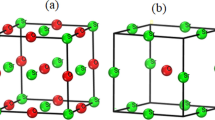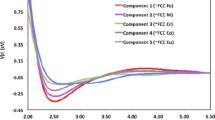Abstract
The divalent ions in alkaline earth chalcogenides are viewed as compressible objects and are treated within a purely ionic model. As in earlier studies on the alkali and ammonium halides, the ions are taken to be in the form of space-filling polyhedral cells and the compression energy, which is the source of repulsion, is written as a surface integral over the cell faces. A simple method of computing the repulsion energy in any crystal lattice of arbitrary symmetry is proposed and the repulsion parametersB andσ are refined for the divalent ions under study. The theory explains the predominant occurrence of the NaCl structure in the alkaline earth chalcogenides. Hard sphere radii are estimated for the tetravalent cations Ti4+, Sn4+ and Pb4+ using the repulsion parameters of O2− ion and the data on the corresponding rutile structure oxides. These radii are seen to be consistent with the measured interionic distances in several compounds occurring in the perovskite structure. The free transfer of repulsion parameters among several structures, which is a key feature of the present approach to repulsion, is confirmed to be valid by the present study.
Similar content being viewed by others
References
Baur W H 1956Acta Crystallogr. 9 515
Bertaut E F 1978J. Phys. 39 1331
Hazen R M and Finger L W 1981J. Phys. Chem. Solids. 42 143
Hildebrand J H 1931Z. Phys. 67 127
Huibregtse E J, Bessey W H and Drougard M E 1959J. Appl. Phys. 30 899
Kim Y S and Gordon R G 1974J. Chem. Phys. 61 1
Krishna Rao K V 1973AIP-Conf. Proc. (USA) 17 219
Ming L C and Manghnani M H 1979J. Geophys. Res. 84 4775
Narayan R and Ramaseshan S 1976J. Phys. Chem. Solids 37 395
Narayan R and Ramaseshan S 1978J. Phys. Chem. Solids 39 1287
Narayan R and Ramaseshan S 1979aPhys. Rev. Lett. 42 992
Narayan R and Ramaseshan S 1979bPramana 13 581
Okai B and Yoshimoto J 1975J. Phys. Soc. Jpn. 39 162
Raghurama G and Narayan R 1983aCurr. Sci. 52 210
Raghurama G and Narayan R 1983bJ. Phys. Chem. Solids 44 633
Shanker J and Verma M P 1976J. Phys. Chem. Solids 37 639
Shannon R D 1976Acta Crystallogr. A32 751
Tessman J R, Kahn A H and Shockley W 1953Phys. Rev. 92 890
Tosi M P 1964 inSolid state physics (eds.) F Seitz and D Turnbull (New York: Academic Press)16 1
Wyckoff R W G 1963Crystal Structures (New York: Interscience) Vol. 1.
Author information
Authors and Affiliations
Rights and permissions
About this article
Cite this article
Raghurama, G., Narayan, R. Theory of divalent ions in crystals. Pramana - J Phys 21, 301–309 (1983). https://doi.org/10.1007/BF02875535
Received:
Issue Date:
DOI: https://doi.org/10.1007/BF02875535




